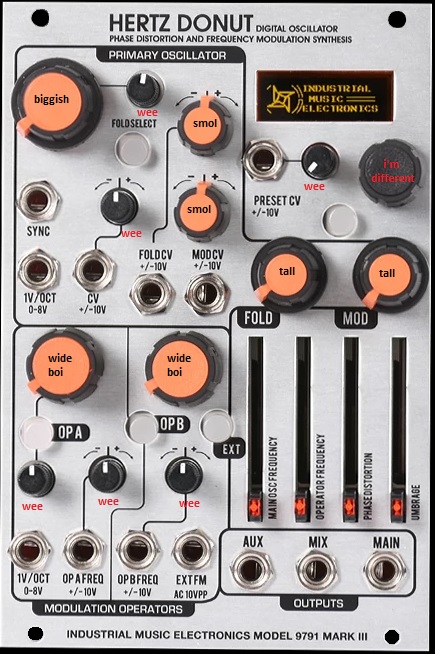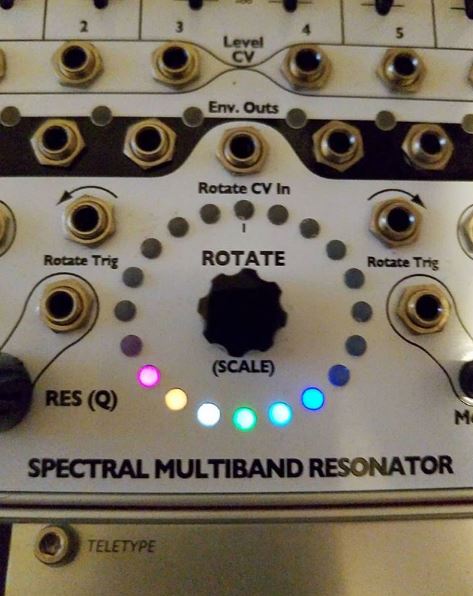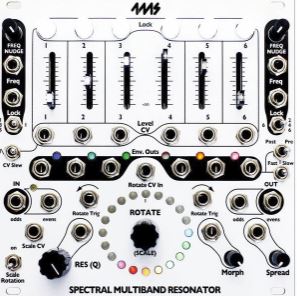The Rossum Electro-Music Panharmonium I pre-ordered almost 4 months ago arrived yesterday. It’s a unique piece of gear that broke my brain a little at first — some of my preconceptions about it were wrong and others didn’t quite grasp all the implications.
What it does is analyze incoming audio and break it into a frequency spectrum, like a prism does for light. Then it uses that data to set the pitch and level of a bank of oscillators to approximately recreate that spectrum. If it did it perfectly without altering anything, it’d be boring… but it isn’t perfect, so it isn’t boring.
It’s a physical law that analyzing the frequency spectrum of audio requires time. (Frequency is a function of time after all.) And the analysis is a bunch of math that also requires at least some computing time. The fastest that Panharmonium can “slice” audio into spectra is 17ms, which is pretty quick but still noticeably chunky to the ears — it can sound a bit like bad MP3 compression depending on the signal and how you’re trying to recreate it. I’ve generally found that slowing it down yields, a little paradoxically, more harmonious results — let it work on a musical event timescale rather than a micro timescale. Synchronize it rhythmically or just let it drift and it can work really well.
On the reproduction side, it’s also intentionally imperfect. You can choose from 1 to 33 oscillators, blur the spectral input to those oscillators, and feed the results back in to the analyzer for a decaying chain of events not unlike reverb. Though the analysis is done with sine waves, you can also set the oscillators to triangle, saw or pulse waves to make them brighter or emphasize harmonics. You can also pitch shift them or skew the relative frequencies. You can do all of this “live” like an effect, or capture a spectrum and then play it back like a VCO, or at high blur and feedback settings kind of a little of both.
The best results I’m getting with it tend toward a sort of psuedo shimmer reverb, harmonization, counterpoint by capturing and holding some notes in the background, turning single notes into chords, supporting notes with bass undertones, and so on.
There are a few quirks that I’d like to see cleaned up in future firmware updates. It’s easy to overload the dynamic range and make it clip — though to its credit, it does so softly and beautifully; it would still be nice to allow some adjustment to keep it clean. The FM range is beyond insane and the knob that’s supposed to tame it needs its curves tweaked or something. The different waveforms don’t blend smoothly into each other, which would be really nice since they can be CV controlled. And all the oscillators in the swarm are fixed in mono, where it might be nice to have a mode to separate them between left and right channels and detune them a little relative to each other for a stereo image. What the chances are of these sorts of updates happening, I have no idea, but sometimes Eurorack developers are really responsive to suggestions and are able to implement all kinds of miraculous fixes and expansions after a release, so I’m hopeful for at least some of these — if not some other stuff that I can’t even conceive of yet.
My only other complaint, and it’s pretty minor, is that the shiny silver-capped knobs on the otherwise lovely panel reflect a lot of light, and the glare makes the little black pointer arrows a little hard to see. I’ve had other modules that are worse about this though. I might move the module to a different row just to see if I can reduce the glare, if I don’t replace the knobs.
Overall it seems like a good module for the sort of dirty ambient that I make — though not an intuitively obvious choice. There’s not really anything else like Panharmonium in the hardware or software world. I thought, when first considering buying it, it might be a bit like Unfiltered Audio SpecOps — also a spectral processor but with a very different focus. Instead, I think comparing it to Red Panda Tensor is more apt — the method couldn’t be more different, but it still creates a sort of harmonized background blurring of time.
I’m curious to try it in a feedback loop with Rings, or to use its output to FM the signal that feeds it… that sort of thing.




